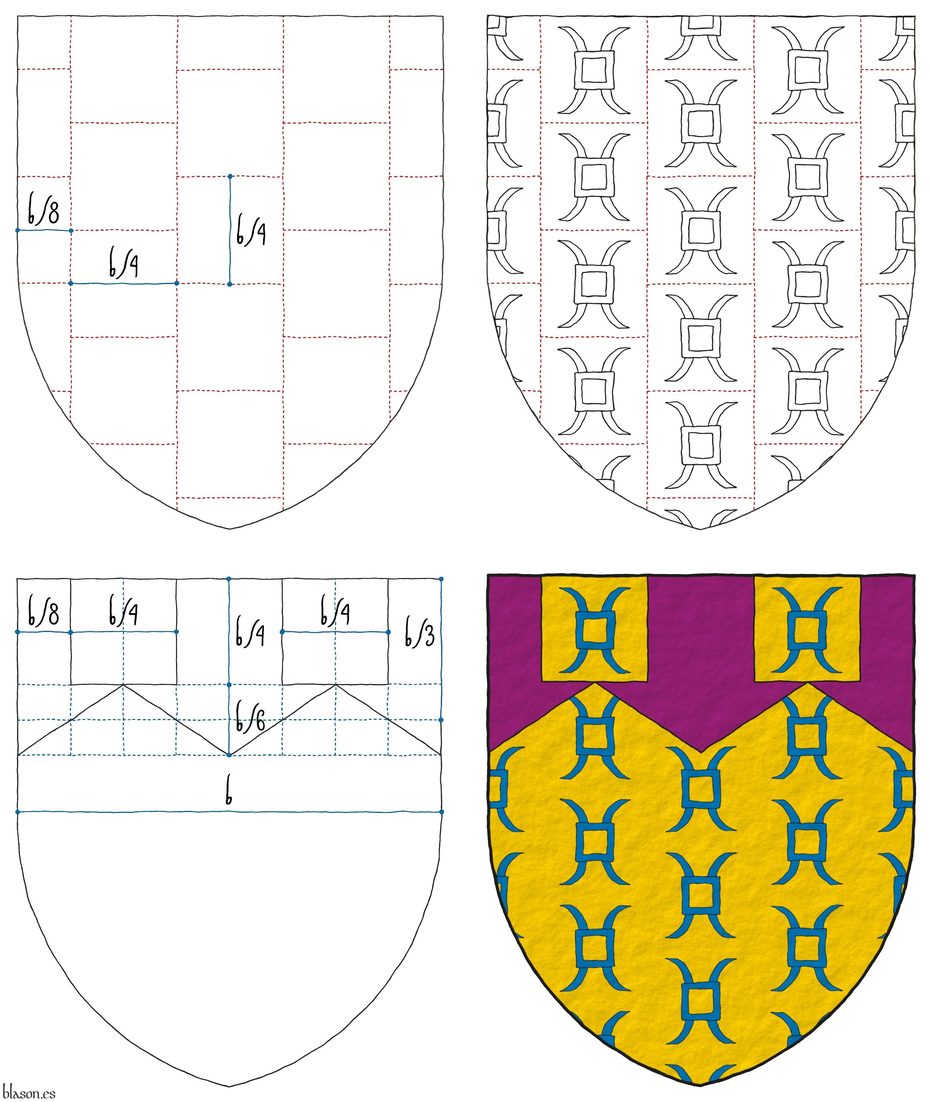Dancetty


Barrio de los Quereres of Mon'Tarena

Argent, a wolf passant Gules, a chief dancetty Azure.
Escudo de plata, un lobo pasante de gules, un jefe centellado de azur.
Coat of arms devised by me, illuminated with lights and shadows, outlined in Sable, with a chasuble outer contour and with a watercolor finish.
The coat of arms of the Barrio de los Quereres of Mon'Tarena, Queretaro, Mexico, designed by Joaquin Haces Perdomo and me and emblazoned by me.
Blazon keywords: Argent, Azure, Gules, One, Wolf, Passant, Chief, Dancetty, Motto and Scroll.
Style keywords: Outlined in sable, Illuminated, Chasuble and Watercolor.
Classification: Civic, Created, Boa and Coat of arms.
Bearer: Barrio de los Quereres of Mon'Tarena.


Barrio de los Quereres of Mon'Tarena, motto

Argent, a wolf passant Gules, a chief dancetty Azure. Motto: «Barrio de los Quereres» Sable with initial letters Gules over a scroll Argent.
Escudo de plata, un lobo pasante de gules, un jefe centellado de azur. Divisa: «Barrio de los Quereres» de sable, con iniciales de gules, sobre una filacteria de plata.
Coat of arms devised by me, highlighted with lights and shadows, outlined in Sable, with a chasuble external shape and with a watercolor finishing.
The coat of arms of the Barrio de los Quereres of Mon'Tarena, Queretaro, Mexico, designed by Joaquin Haces Perdomo and me and emblazoned by me. In this case, the tinctures Azure, Gules, and Argent have been adjusted to match the official colour palette of Mon'Tarena.
Blazon keywords: Argent, Azure, Gules, Sable, One, Wolf, Passant, Chief, Dancetty, Motto and Scroll.
Style keywords: Outlined in sable, Illuminated, Chasuble and Watercolor.
Classification: Civic, Created, Boa and Coat of arms.
Bearer: Barrio de los Quereres of Mon'Tarena.


Baz Manning, schema 2x2
Or semé of millrinds Azure; a chief dancetty of two full points upwards Purpure pierced twice of the field billetwise throughout.
The coat of arms of Baz Manning, John Basil Edward, emblazoned by me in 4 steps. In the English blazon, I followed his style, and in the Spanish blazon, I followed mine, counting the pieces of the chief that fit from the perspective of the chief.
Blazon keywords: Or, Azure, Purpure, One, Two, Three, Semé, Millrind, Chief, Dancetty, Pierced, Billet and Throughout (chief base).
Style keywords: Ratio, Outlined, Outlined in sable, Plain tincture and Pointed.
Classification: Personal, Interpreted, Schema, Boa and Coat of arms.
Bearer: Manning, Baz.


Beninger, Manuel
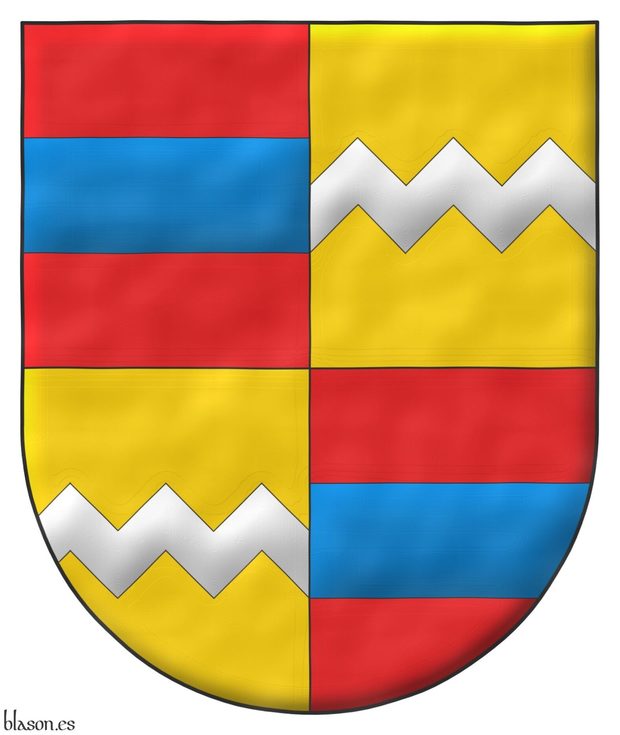
Quarterly: 1 and 4 Gules, a fess Azure; 2 and 3 Or, a fess dancetty Argent.
Escudo cuartelado: 1o y 4o de gules, una faja de azur; 2o y 3o de oro, una faja encajada de plata.
Coat of arms emblazoned by me with a semi-circular ended shape, illuminated, and its finishing is that seems watercolor.
According to the armiger «the origin of this coat of arms is from Austria and hence the unusual combination of colors and metals».
Blazon keywords: Quarterly, Gules, One, Fess, Azure, Or, Dancetty and Argent.
Style keywords: Colour on colour, Metal on metal, Semi-circular, Outlined in sable, Illuminated and Watercolor.
Classification: Personal, Interpreted and Coat of arms.
Bearer: Beninger, Manuel.


Dancetty, ratio, points and blazon

Party per fess Or and Gules dancetty of three full points and two half upwards.
Escudo cortado, encajado de tres piezas enteras y dos medias.
[Avilés, J.; 1780a; page 79], on the appropriate dimensions for outlining an indented shield, he explains that «encaxadas» or «emanchadas» refers to «the partitions of the shield, whose pieces fit into each other in the shape of thick and long triangles, which are regularly one-third of the length», that is, of the width of the shield for parted shields, «or of the height of the shield», that is, the height for fess shields, as in this example, «depending on the direction in which these figures are placed in the parted, fess, bend, and cut shields, etc. but being a Chief, they have half the base and the rest as point; and if it were a Fess, it is formed of alternating triangles, which fill it completely».
[Avilés, J.; 1780a; page 80], on which of the two components of an indented shield acts as the field and which as the piece, he clarifies that «the field of the partition is understood as the one occupying the upper part of the shield, with the lower part at the base considered the piece».
[Avilés, J.; 1780a; page 80], on how the blazon of an indented shield should be drafted, he establishes that «the number of whole and half triangles must be specified when there is more than one, and likewise, the direction in which the partitions are in the parted, fess, etc.», illustrating it with 2 examples that can also be seen in [Avilés, J.; 1725a; plate 8, illustrations 157 and 158].
Blazon keywords: Party per fess, Dancetty, Three and Two.
Style keywords: Semi-circular.
Classification: Schema.


Frank, Markus Hermann

Party per fess dancetty of three points Gules and Argent, in chief a winnowing fan reversed Or between two fleams addorsed Argent.
Escudo cortado de gules, encajado de tres piezas enteras de plata, en jefe, un aventador ranversado de oro acompañado de dos lancetas adosadas de plata.
Coat of arms painted by me, highlighted with lights and shadows, outlined in Sable, with a semi-circular outer contour and with a freehand finish.
G0129, Chief Herald of Arms of Malta's grant of the coat of arms of Markus Hermann Frank, USA. This coat of arms has been emblazoned by me.
Design rationale
The coat of arms of Markus Hermann Frank features a Franconian Rake, a heraldic reference to his surname, making this a case of canting arms. The Franconian Rake is the historical emblem of the Franconia region in Germany, traditionally blazoned as per fess dancetty of three points Gules and Argent. He is a Medical Doctor and an Associate Professor at Harvard Medical School, which is reflected in the two fleams, surgical instruments historically used in medicine.
Blazon keywords: Gules, Argent, Or, One, Two, Three, Party per fess, Dancetty, In chief, Winnowing fan, Reversed, Between and Fleam.
Style keywords: Outlined in sable, Illuminated, Semi-circular and Freehand.
Classification: Personal, Interpreted, Design rationale, Boa and Coat of arms.
Bearer: Frank, Markus Hermann.


Full achievement of Markus Hermann Frank
Party per fess dancetty of three points Gules and Argent, in chief a winnowing fan reversed Or between two fleams addorsed Argent. Crest: Upon a helm befitting his degree issuant from a crown of Baron above the shield, with a wreath Argent and Gules, two arms embowed proper, vested Sable, cuffed Or, holding aloft a winnowing fan reversed Or. Mantling: Gules doubled Argent. Motto: «Ora et Labora». Supporters: Two lions passant, tails addorsed Sable, armed and langued Gules.
Coat of arms depicted by me, illuminated with lights and shadows, outlined in Sable, with a semi-circular outer contour and with a freehand finish.
G0129, Chief Herald of Arms of Malta's grant for the arms of Markus Hermann Frank, USA. These arms have been emblazoned by me for such grant.
Blazon keywords: Gules, Argent, Or, Sable, One, Two, Three, Party per fess, Dancetty, In chief, Winnowing fan, Reversed, Between, Fleam, Addorsed, Crest, Upon (wreath), Helm, Issuant, Crown of Baron, Crown, Above the shield, Wreath, Arm, Embowed, Proper, Vested, Cuffed, Grasping, Mantling, Doubled, Motto, Supporter (animal), Supporter, Lion, Passant, Tail addorsed, Armed and Langued.
Style keywords: Outlined in sable, Illuminated, Semi-circular and Freehand.
Classification: Personal, Interpreted, Boa and Coat of arms.
Bearer: Frank, Markus Hermann.


Gudja, municipality of

Argent, a fess dancetty of four points Gules.
Escudo de plata, una faja encajada de cuatro piezas de gules.
Coat of arms depicted by me, highlighted with lights and shadows, contoured in Sable, with a pointed outer contour and with a freehand finish.
G0138, Chief Herald of Arms of Malta's grant of the coat of arms of the municipality of Gudja, Malta. This coat of arms has been emblazoned by me and has been published in the Malta Government Gazette, number 21486, page 10730, with the blazon «Argent a fess dancetty of four points counterdancetty of three points all Gules».
Blazon keywords: Argent, Gules, Four, Fess and Dancetty.
Style keywords: Outlined in sable, Illuminated, Pointed and Freehand.
Classification: Civic, Interpreted, Boa and Coat of arms.
Bearer: Gudja, municipality of.


![Ver [Latidos Podencos] en criterios utilizados. Unicornio saltante sobre la divisa, criterio.](../css/Unicornio.Criterio.png)
Latidos Podencos

Gules: a warren hound parado statant Or; a base hearty Or.
Escudo de gules: un podenco parado de oro; la campaña encajada de corazones de oro.
Coat of arms that I have created with: the shield’s shape pointed and rounded; its field painted in flat tint gules; the warren hound and the base hearty are illuminated Or and delineated Sable; and the whole is executed in raised-line drawing.
Symbolism
A base made of generous hearts Or, interlocked with hearts Gules, red as blood, gives its support to a Spanish warren hound standing upon it. They are the hearts of those who love, protect and care for the hounds, intertwined with the hearts of the hounds whose noble heartbeats are evoked in the motto.
The founders of this Spanish warren hound shelter did not wish for a dog armed and langued, since those heraldic attributes would imply that the animal is not truly in need of protection. They preferred instead to highlight the podenco’s loyalty and faithfulness.
Types of lines of division
In English heraldry, ordinary lines of partition such as «almenado» ~ «embattled», «acanalado» ~ «invected», or «angrelado» ~ «engrailed» have well-established names. There is, however, no general rule for blazoning lines formed by repeated and more elaborate figures, such as fir trees, fleurs de lis, or other shapes.
Each case tends to receive a descriptive or newly coined term, such as «sapiné» or «flory» «flory counterflory», in these last two cases depending on whether the figures all point in one direction or alternate upward and downward.
Note that in «sapiné» the charm lies precisely in that alternation: the fir trees point alternately upward and downward, so that the figures interlock with each other.
Therefore, if a new figure appears, such as the heart in this case, with hearts pointing upward, one might say «hearty» or, more specifically, «hearty counterhearty»; but following the example of «sapiné», we shall simply blazon «hearty».
For example, the line formed by dovetail shapes, called «dovetailed» in English, is blazoned in Spanish as «encajada de colas de milano», even changing the name of the bird. Note that in this case they interlock precisely because some point upward and others downward, hence their use in joinery, cabinetry, and related arts.
In Spanish there are classical terms for the most common forms, such as «almenado», «acanalado» or «angrelado», with «encajado» ~ «dancetty» being perhaps the most characteristic, where the angles interlock alternately upward and downward.
When facing new or uncommon shapes, instead of inventing a new term we prefer to use the basic one, «encajado», adding afterwards the specific figure that forms the interlock, for example, «encajado de abetos» ~ «sapiné».
Thus, in this case we blazon «the base hearty», with the hearts alternating upward and downward, just as in the traditional «encajado» the angles alternate both ways.
Blazon keywords: Without divisions, Gules, Or, Warren hound, Dog, Base, Base (lower 1/3), Dancetty and Heart.
Style keywords: Ogee, Illuminated, Outlined in sable and Freehand.
Classification: Created, Socioeconomic, Design rationale, Criterion and Coat of arms.
Bearer: Latidos Podencos.


Latidos Podencos, seal of the animal protection organization
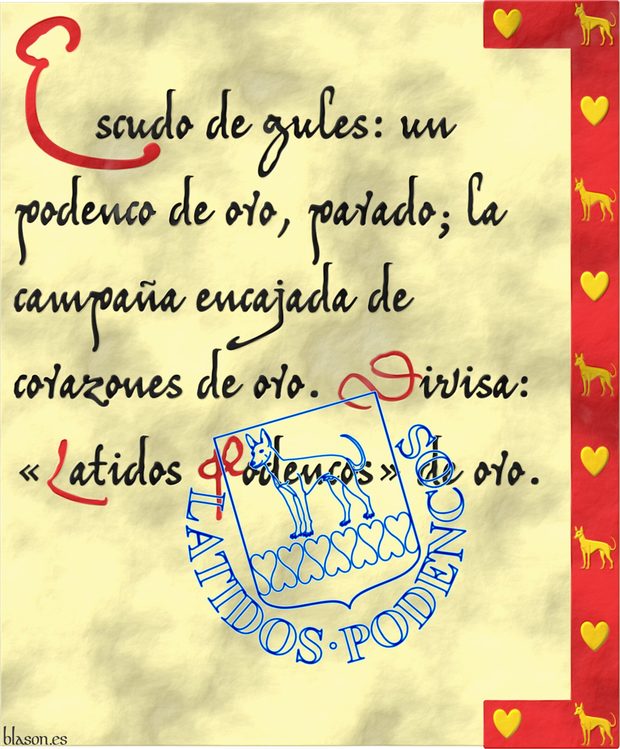
Protectora del podenco español.
I have created the seal of the shelter Latidos Podencos based on its coat of arms.
[Avilés, J.; 1780a; page 79, third paragraph from the beginning] writes that «Encaxadas, or emananchadas», from the French «émanche», and in English sometimes rendered as «emanche» and other times described as «line of», refers to «those partitions of the shield whose pieces fit one into another in the form of thick and elongated triangles, which are usually one-third of the length or width of the shield, depending on the direction in which these figures are placed in a per pale, per fess, per bend, or per bend sinister division, etc. But when it is a chief, they have half the base and the rest pointed; and if it is a fess, it is formed by alternating triangles filling it entirely». This description corresponds to the most general form of the «encajado», although there may be other ways to position it —in this case, in the base— and other types of «encajado» depending on the figures represented, such as those made of fir trees, Latin crosses, or, as in this case, of hearts.
Blazon keywords: Without divisions, Dog, Base, Dancetty, Heart and Motto (identification).
Classification: Seal, Created and Socioeconomic.
Bearer: Latidos Podencos.


Manning, Baz

Or semé of millrinds Azure, a chief dancetty of two full points upwards Purpure pierced twice of the field billetwise throughout.
Escudo de oro sembrado de anillas de molino de azur; un jefe encajado de tres piezas, una completa y dos medias, de púrpura y perforado de dos billetes movientes del jefe a la punta.
Arms interpreted by me, highlighted with lights and shadows, outlined in Sable, with a pointed outer contour and with a watercolor finish.
The coat of arms of Baz Manning emblazoned by me. John Basil Edward, known as Baz Manning, was commissioned to make the coat of arms for King Felipe VI of Spain as a member of the Most Noble Order of the Garter, which is now displayed among the many shields in St. George's Hall, Windsor Castle. I had the honor of assisting him with this project, which, although my contribution was small, was incredibly meaningful to me. Baz graciously acknowledged my assistance, stating that my detailed insights on the Spanish royal arms have been included in the records of the Order of the Garter for the Windsor Castle archive and the Heraldry Society.
Blazon keywords: Or, Azure, Purpure, One, Two, Three, Semé, Millrind, Chief, Dancetty, Pierced, Billet and Throughout (chief base).
Style keywords: Outlined in sable, Illuminated, Pointed and Watercolor.
Classification: Personal, Interpreted, Boa and Coat of arms.
Bearer: Manning, Baz.


Manuel Beninger, page of armorial
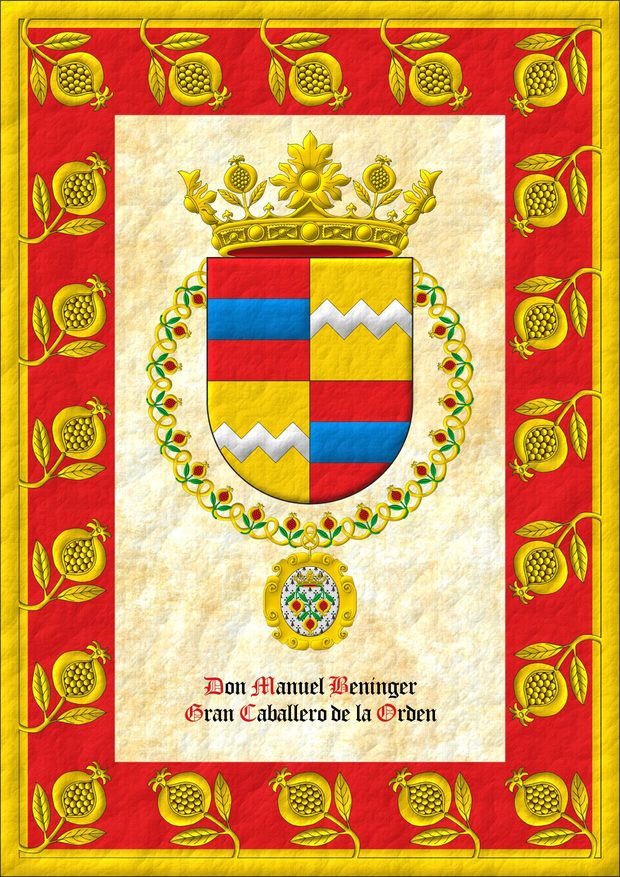
Quarterly: 1 and 4 Gules, a fess Azure; 2 and 3 Or, a fess dancetty Argent. Crest: A crown of the Sovereign and Most Noble Order of the Pomegranate. The shield is surrounded by the Grand Collar of the Sovereign and Most Noble Order of the Pomegranate.
This is his coat of arms of emblazoned by me for the Roll of Arms of the Sovereign and Most Noble Order of the Pomegranate.
Blazon keywords: Quarterly, Gules, One, Fess, Azure, Or, Dancetty, Argent, Crest and mantling, Crown, Pomegranate, Surrounded and Grand collar.
Style keywords: Colour on colour, Metal on metal, Semi-circular, Outlined in sable, Illuminated and Leather.
Classification: Personal, Interpreted, Coat of arms, Armorial roll and Castilian language.
Bearer: Beninger, Manuel.


Municipality of Gudja
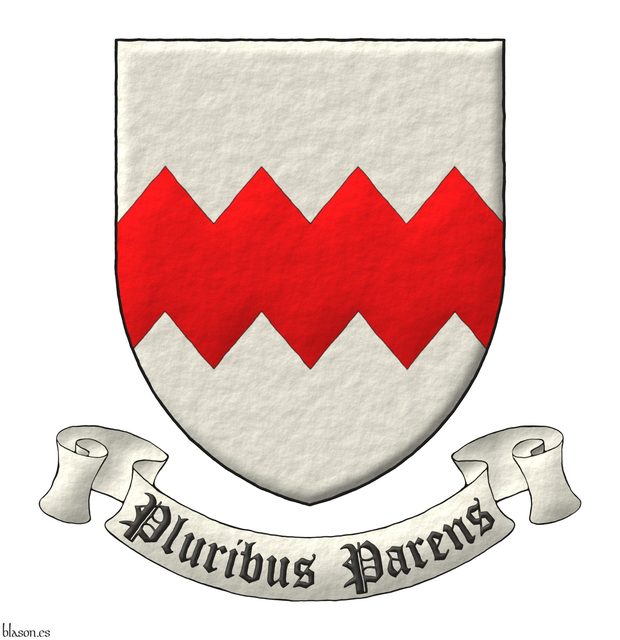
Argent, a fess dancetty of four points Gules. Motto: «Pluribus Parens».
Escudo de plata, una faja encajada de cuatro piezas de gules. Lema: «Pluribus Parens».
Arms emblazoned by me, illuminated with lights and shadows, contoured in Sable, with a pointed external shape and with a freehand finishing.
G0138, Chief Herald of Arms of Malta's grant for the arms of the municipality of Gudja, Malta. These arms have been emblazoned by me for such grant. The motto «Pluribus Parens» means «mother of many children», as Gudja was the historical center and origin of several nearby settlements such as Safi, Kirkop, Luqa, Mqabba, Tarxien, and others.
Blazon keywords: Argent, Gules, Four, Fess, Dancetty and Motto.
Style keywords: Outlined in sable, Illuminated, Pointed and Freehand.
Classification: Civic, Interpreted, Boa and Coat of arms.
Bearer: Gudja, municipality of.


Urban V

200th Pope of the Church, from 1362 to 1370. «Urbanus V», born Guillaume de Grimoard, was born in Le Pont-de-Montvert, in the Languedoc.
Gules, a chief dancetty of four full points Or.
Escudo de gules, un jefe encajado de cuatro piezas enteras de oro.
Papal coat of arms interpreted with: a round-topped shield; the field in plain Gules; the chief indented, illuminated in metal Or, and outlined in Sable; and the whole design in hammered metal.
[Rietstap, J. B.; 1861] blazons it as Grimoard «de gueules, au chef émanché de quatre pièces d'or».
Blazon keywords: Gules, Chief, Dancetty, Or, Three and Two.
Style keywords: Semi-circular, Illuminated, Outlined in sable and Metal beaten.
Classification: Interpreted, Religious and Papal States.
Bearer: Urban V.
-
Language
-
Categories of heraldry
-
Divisions of the field
- Without divisions
- Party per pale
- Party per fess
- Party per bend
- Party per bend sinister
- Tierce
- Tierce sinister
- Tierced per pale
- Tierced per fess
- Tierced per bend
- Tierced pallwise inverted
- Quarterly
- Quarterly per saltire
- Gyronny
- Party per fess, the chief per pale
- Party per pale, the sinister per fess
- Party per fess, the base per pale
- Party per pale, the dexter per fess
- Chapé
- Chaussé
- Embrassé
- Contre-embrassé
- Party per chevron
- Enté
- Enté en point
- Flanched
-
Metals
-
Colours
-
Furs
-
Other tinctures
-
Ordinaries and sub-ordinaries
-
Diminutives of the ordinaries
-
Geometric charges
-
Composite ordinaries
-
Inanimate charges from Nature
Atom, Crescent, Diamond, Emerald, Estoile, Increscent, Lightning flash, Moon, Mount, Mullet, Mullet of four points, Orbital, Plough of Ursa Major, Rainbow, Ray of the sun, River, Sea, Snowflake, Sun, Sun in splendour, Sun of May, Trimount and Water.
-
Vegetal charges from Nature
Acorn, Apple, Apple tree, Ash, Bluebonnet, Camellia, Chrysanthemum, Cinquefoil, Cornflower, Dogwood flower, Double rose, Elm, Fleur de lis, Flower, Gourd, Holm oak, Hop cone, Kapok tree, Laurel, Lily, Linden, Lotus flower, Madonna lily, Oak, Olive tree, Palm tree, Pomegranate, Poplar leaf, Rose, Shamrock, Sunflower, Thistle, Tree, Tulip, Vine and Wheat.
-
Animal charges from Nature
Badger, Bald eagle, Barbel, Barn owl, Bear, Beaver, Beetle, Bighorn sheep, Blackbird, Boar, Brach hound, Bull, Doe, Dog, Dolphin, Dove, Eagle, Elephant, Falcon, Fish, Flame, Fly, Fox, Frog, Goat, Goldfinch, Goose, Heron, Horse, Hummingbird, Jaguar, Lark, Leopard, Lion, Lion passant, Lion rampant guardant, Lioness, Lynx, Male figure, Martlet, Merino ram, Owl, Panther, Parrot, Peacock, Pelican, Pelican in her piety, Puffin, Quetzal, Raven, Roe deer, Rooster, Savage, Seagull, Serpent, She-wolf, Stag, Starling, Talbot, Tyger, Vulture, Warren hound and Wolf.
-
Parts of natural charges
Arm, Beak, Branch, Caboshed, Chest, Claw, Covert, Dorsal fin, Eagle claw, Ermine spot, Escallop, Feather, Foot (palmiped), Foreleg, Forepaw, Hand, Head, Heart, Hoof, Leaf, Neck, Ostrich feather, Palm frond, Paw, Roe deers' attires, Shoulder, Sprig, Stags' attires, Stem, Swallow-tail, Tail, Tail addorsed, Tail fin, Talon, Tooth, Trunk, Trunk (elephant), Two hands clasped, Two wings in vol, Udder, Wheat spike, Wing and Wrist.
-
Artificial charges
Ace of spades, Anchor, Anvil, Arch, Arm vambraced, Armillary sphere, Arrow, Axe, Bell, Bell tower, Beret, Bonfire, Book, Bookmark, Bow, Bridge, Broken, Buckle, Cannon, Cannon dismounted, Cannon port, Canopy roof, Carbuncle, Castle, Celtic Trinity knot, Chain, Chess rooks, Church, Clarion, Clay pot, Closed book, Club, Comb, Compass rose, Conductor's baton, Cord, Covered cup, Crozier, Crucible, Cuffed, Cup, Cyclamor, Dagger, Double vajra, Drum, Ecclesiastical cap, Fanon, Federschwert, Fleam, Four crescents joined millsailwise, Galician granary, Garb, Gauntlet, Geometric solid, Grenade, Halberd, Hammer, Harp, Host, Hourglass, Key, Key ward, Knight, Knot, Lantern, Letter, Line, Loincloth, Menorah, Millrind, Millstone, Millwheel, Monstrance, Mortar, Mullet of six points pierced, Nail, Non-classic artifact, Norman ship, Number, Oar, Oil lamp, Open book, Page, Pair of scales, Parchment, Pestle, Piano, Pilgrim's staff, Plough share, Polish winged hussar, Port, Portcullis, Potent, Quill, Ribbon, Rosette of acanthus leaves, Sabre, Sackbut, Sail, Scroll, Scythe, Sheaf of tobacco, Ship, Skirt, Spear, Spear's head, Stairway, Star of David, Step, Sword, Symbol, Tetrahedron, Torch, Tower, Trident, Trumpet, Turret, Two-handed sword, Wagon-wheel, Water-bouget, Wheel, Winnowing fan and With a turret.
-
Immaterial charges
Angel, Archangel, Basilisk, Dragon, Dragon's head, Garuda, Golden fleece, Griffin, Heart enflamed, Mermaid, Our Lady of Mercy, Ouroboros, Paschal lamb, Pegasus, Phoenix, Sacred Heart of Jesus, Saint George, Sea-griffin, Trinity, Triton, Unicorn, Winged hand and Wyvern.
-
External elements
-
Heraldic creations
-
References
-
Formats
-
Keywords on this page
Between, Watercolor, Millrind, Pointed, Winnowing fan, Azure, Barrio de los Quereres of Mon'Tarena, Beninger, Manuel, Billet, Boa, Base, Chasuble, Colour on colour, Heart, Crown, Party per fess, Created, Quarterly, Four, Outlined in sable, Two, In chief, Dancetty, Coat of arms, Schema, Fess, Scroll, Frank, Markus Hermann, Personal, Gudja, municipality of, Gules, Illuminated, Interpreted, Chief, Fleam, Latidos Podencos, Motto, Wolf, Manning, Baz, Semi-circular, Metal on metal, Throughout (chief base), Or, Passant, Argent, Civic, Freehand, Three and One.

